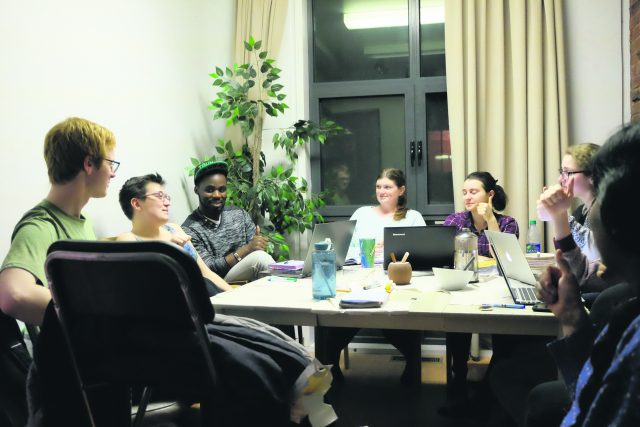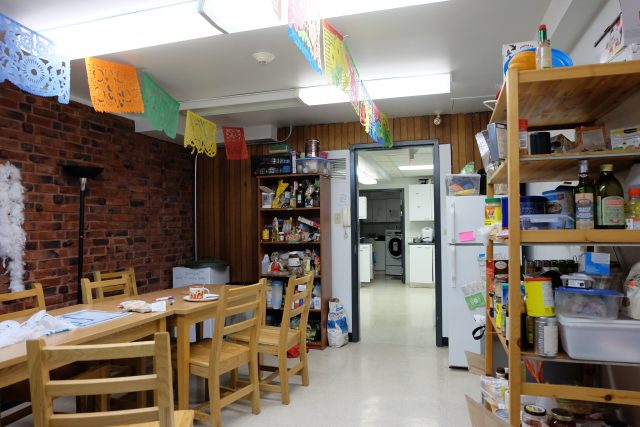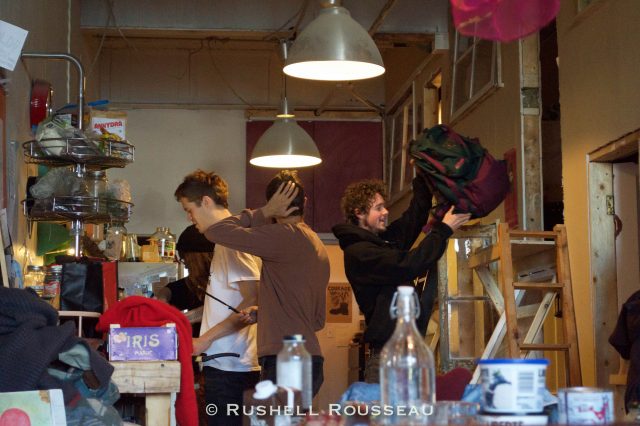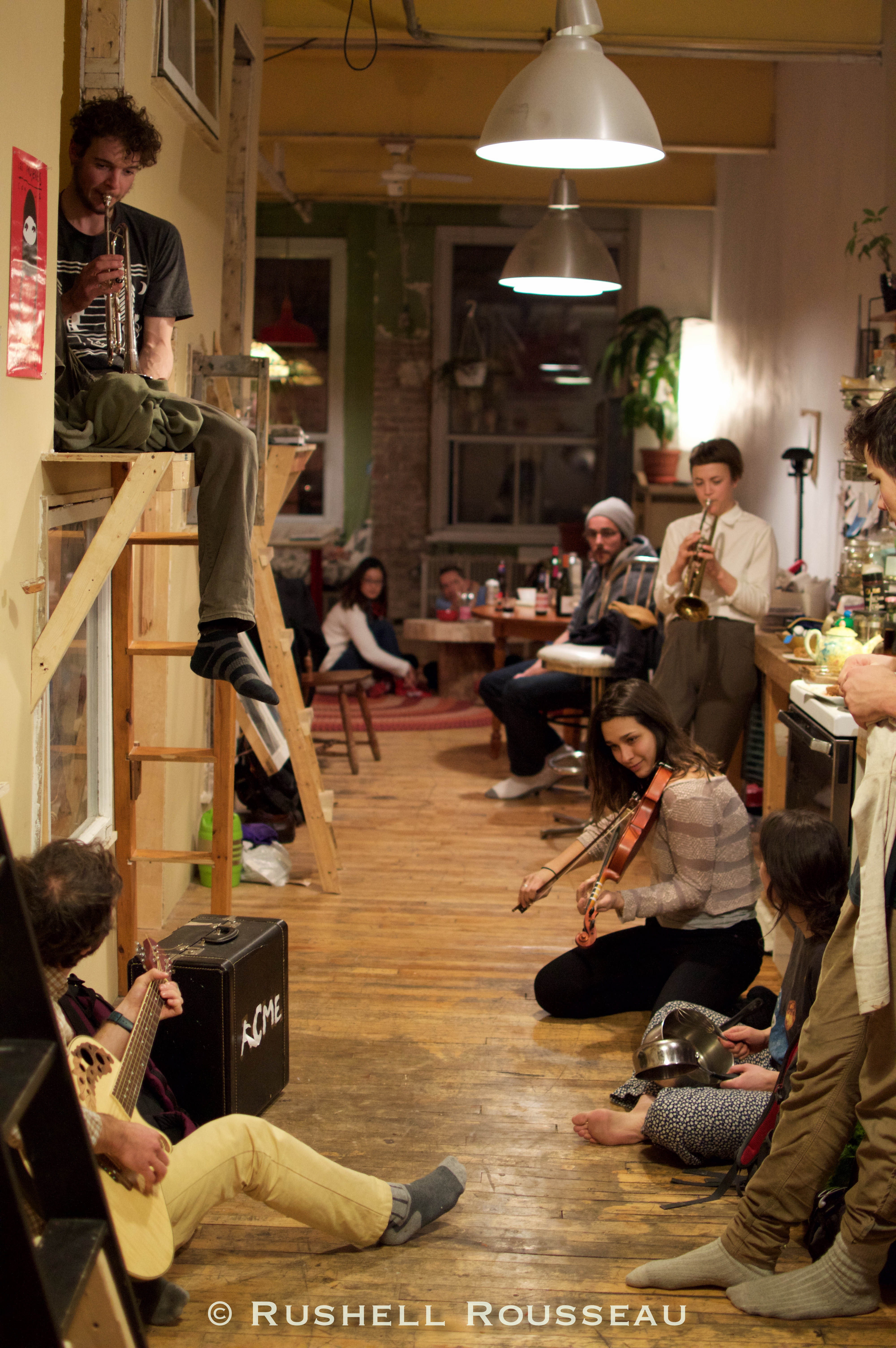I shared an apartment wall with a baby for two school years. On one side of the wall was my bed, and just on the other side of the wall, there was probably a crib. Based on muffled noises, I could tell you that there was a parent or guardian that also lived there, and that the baby’s communication skills gradually advanced from giggles and screams to a few more sophisticated sounds over the course of the time that we were neighbours. I couldn’t tell you any more details than that, though, because I never really interacted with them, barring one time they pounded on the wall when I was blasting music. Despite living and existing mere feet away from each other, not once did we meet face-to-face.
This may seem inconsequential – in a big city, never meeting your neighbours could even be considered normal. But for most of human history, we have survived and thrived in environments ranging from arid deserts to the high Arctic tundra through forms of group membership and interdependence. It was only relatively recently, with the rise of liberalist ideology and globalization, that the dominant mode of social organization has fragmented to smaller units, like the individual and the nuclear family. We’ve bought into a myth that we should be able to meet all of our needs relatively independently, despite it being completely contrary to our nature. Of course, we now have technologies that enable us to obtain food, water and shelter with much greater ease than the preIndustrial humans. But the importance of communities goes beyond meeting our basic needs – there is a growing understanding of the negative impacts that individualistic living has on our mental, emotional, social, and spiritual health. This phenomenon is known as “urban isolation,” or the disconnectedness that is increasingly prevalent in cities.
In many ways, students are particularly vulnerable to the effects of urban isolation. Transitioning to university often means uprooting ourselves from communities which may have once provided a sense of stability and belonging, such as schools, families, sports, or musical activities. Most of us don’t yet have much in the way of stakes in the ground for The Future, and in our early twenties, we’re straddling the divide in the normative narrative between living with parent(s) and/or guardian(s) and beginning a family with a partner. During this time, we are under an immense amount of pressure – to build our identities, construct unique professional ‘brands,’ and optimize the limited windows of opportunity that our university years present. McGill’s size, location downtown and sense of competition exacerbate this; we are constantly surrounded by seas and skyscrapers of people who constantly seem to be smarter, more sociable, better-dressed, and generally more ‘together.’

Barraged with the imagined success of others and without a firm community or sense of longterm direction in the city, I have felt a profound sense of loneliness at several points throughout my degree, especially while I lived independently. I’m not talking about clinical depression, which can be intimately related to this feeling but deserves separate consideration. I mean the shades of melancholy that thrive under high expectations and in dark winters; in the absence of a sense of direction, of home and of rootedness. I mean the cold feeling of emptiness when there isn’t the smell of dinner cooking, another human to tell you about their day, or someone to just say goodnight to when the day is done. I know I’m far from the only one who has felt this at some point during their time at McGill.
Much of the rhetoric surrounding our shift towards disconnection places the blame on younger demographics – those self-absorbed, materialistic millennials. Instead of blame, I look to pockets of our generation for inspiration about alternative ways to exist in a profit-driven, individualistic society, often created as a direct response to the isolation that so often comes with being a young adult trying to figure it all out. Friends, peers, and I have all voluntarily contributed significant amounts of energy towards building spaces and associated communities throughout the city where the values and principles we wish to see flourish can do so. Many of us, myself included, have experienced first-hand how collective living can break down urban isolation and represent a powerful way to bring our politics and our visions home – literally.
“A microcosm of what society can be”
I lived at ECOLE, a student collective centred on social & environmental sustainability which also acts as a meeting space for campus and community groups, during my fourth year at McGill. I went from a quiet 4½ to a home where I was suddenly surrounded by people, where I would walk past group meetings, movie screenings, potlucks and coffeehouses on my way through the house. Suddenly, it was hard for feelings of loneliness to ever be as profound or intense when there was always someone making sure I got dinner, when nine others were depending on me for theirs, when I could always hear a productive meeting or a deep discussion or a song a room away. Going from one extreme to the other made me realize the potential that collective living has to make people and communities more resilient.
A living collective – also known as a communal living space – is a space where a group of individuals shares responsibilities and resources and intentionally builds community around a common interest, identity, or set of values. In practice, a living collective might do this in any number of different ways, such as hosting community events, sharing cooking responsibilities, making collective bulk purchases, distributing rent according to financial need, employing consensus-based decision making, or holding regular meetings to resolve conflicts and discuss each other’s needs. In most collectives, members share a common social vision and many embrace alternative lifestyle practices, such as minimalism, zero-waste or permaculture. In this sense, living collectives are one way of many for groups of people to develop a greater degree of autonomy from externally-imposed systems, norms, and rules, and instead internally co-create their own from the ground up.
Collective living spaces are commonly thought to have taken off in the 1960s in the United States with the emergence of hippie culture. At this time, counter-cultures of young people developed largely in opposition to U.S. military involvement in Vietnam, a movement characterized in large part by mistrust of the government, artistic expression and a desire to exist in harmony with nature. Many members of the hippy movement lived in ‘communes’, or anti-establishment spaces where property, resources, work and income are all shared, and many variations of this model continue to exist in different parts of the world today.
However, it is important to note that while predominantly white, Western hippies brought collective living into white, Western cultural consciousness, forms of collective living have existed in many countries and cultures throughout history. For example, interconnectedness is deeply embedded in Inuit tradition, which is partly illustrated through their sophisticated set of norms and practices related to hunting, fishing and sharing food through social networks. Today, extended families or even friend groups often live together and act as supportive, intentional community, without explicitly calling themselves a “living collective.” The ‘hippie commune’ genesis story of collective living may be the most dominant one, but in addition to being white-centered, it erases the diversity of ways in which various cultures and societies have historically practiced collective living, and bring those practices into society today.
In Montreal, you can hardly throw a rock without hitting a living collective – each with their own ethos and set of practices. Many of them were created or sustained by McGill students and graduates, who shared their experiences of collective living with me. Nimra Bandukwala, a U3 Psychology and World Religions student, lives in a collective loft called Les Échelles on St. Laurent, which she started this year with five friends. “In a way, it’s just a microcosm of what society can be, because urban isolation and things like this all just stem from the individualism that we’re forced to believe we are in,” she said. She told me that living collectives allow for a community to control the use of resources, in a way that is often lacking in society outside of them. “The moment we realize that you can trust others with things we usually do ourselves like cooking, I think that’s the most revolutionary. Others care about you, and people aren’t selfish.”

Kristen Perry, who graduated from McGill last year with a degree in Agricultural & Environmental Science, started her own collective called GreenhouseMTL with a small group of friends this year. “The main thing for me is that you’re trying to build a community that really works for everyone that’s involved. Everyone has different needs and boundaries, so the goal should be to make it a place where everyone can feel safe and comfortable and is benefiting. For a collective to work, it should be a lot easier to live than when you’re on your own.”
Perry elaborated on how collective living can be made more financially accessible by distributing rent according to financial need. “We have different levels of income, or ability to pay, so we try to communicate openly about our needs and have a system in place to help minimize financial stress for the people living in the house,” she explained. “It’s a matter of equity, because it’s a redistribution of resources based on who needs them and who can provide them. But it goes beyond just money – everyone’s bringing what they can to our home, whether it’s time, art, experience, food, skills, or anything else.
Danji Buck-Moore, who graduated from McGill in 2012, has been involved in a long-established Mile End loft and collective living space centred on arts and music, for several years. “It’s a really interesting moment in the world of collectives in Montreal,” he told me. “There have been a lot of these spaces closing down over the last few years, more than in the few years before that. But new ones keep getting started, and the only way that happens is if people are throwing themselves into it.”
Built-in support systems
There is a mental health epidemic on university campuses, with record numbers of students being diagnosed with depression and anxiety. Loneliness can certainly be an effect of mental ill-being, but it can also be a cause of it. Many collective members I interviewed told me that collectives can often act as built-in support networks during times of need or stress. Bavna Bhagavat, who graduated last year with a degree in Anatomy & Cell Biology, also spent a year living in ECOLE. “I think collective living is really conducive to better emotional and psychological well-being,” Bhagavat explained, noting that ECOLE residents would often discuss how to best support one another through difficult times.
Sharing space and resources with a handful or dozens of other people may seem overwhelming, especially for those inclined to introversion – but having a network of support does not necessarily mean constantly having to engage with others. “I personally really enjoy the possibility of being surrounded by people, but also the possibility of being by myself in my room,” explained Bandukwala. “We become very perceptive to each other, so the moment something’s wrong, someone immediately senses it and will ask. There’s something very special about being able to give support to your roommates, really feeling like they’re siblings or family. You don’t only see them in the bright light and stars, you also see them when they’re really struggling.”
Shared meals are the keystone of most collectives, alleviating the stress of constantly grocery shopping and cooking for one. A system inspired by the Beehive Collective House in Vancouver involves members taking turns cooking dinner for everyone else, choosing their cooking nights at the start of each cycle, which has as many days as there are people. The collective sets parameters for their meals in advance, such as dietary restrictions and what time it should be ready. If someone isn’t home for dinner, the collective will save a container for them for later, so the system lends itself well to student schedules, which are often extremely busy and unpredictable.
It is important to note that while predominantly white, Western hippies brought collective living into white, Western cultural consciousness, forms of collective living have existed in many countries and cultures throughout history.
Alan Chen, a U4 Sustainability, Science & Society student who lived in the GreenhouseMTL collective last semester, was particularly excited to begin this system with his roommates when they started their collective last fall. “[When living independently], you get anxious about when to buy groceries, how much they’re going to cost, what you’re going to make, and whether or not it’ll last you the week,” he said. In addition to a meal-sharing schedule, Chen also noted that one of his roommates would frequently bring home fruits, vegetables and other food from dumpster diving trips. “I had a realization that this is what food security felt like,” he said. “Cooking one big meal every five days is much easier than five smaller ones.”
Seeds of change
Collective living can also be used to promote environmentally-responsible living habits, such as zero-waste lifestyles, vegetarian/vegan eating, and DIY projects like fermenting or pickling. This is not to suggest that simply changing our living habits is a panacea for our current environmental crisis, nor that everyone is equally able to prioritize and access opportunities to do so. However, living collectives can facilitate a lifestyle which is less environmentally destructive than the status quo. Perry noted, “It’s more efficient to live in groups than alone, in terms of waste, energy, and consumption. So even if the goal of the collective is not sustainability, it’s likely going to be more sustainable, environmentally speaking, anyway.”
Katie Friedman, a U3 Linguistics student, elaborated on ECOLE’s environmental practices, including worm composting and maintaining a garden in the front yard to grow some of their own food. “In the fall, two of us would split one Community Supported Agriculture basket, so among the whole house, we shared three or four baskets of vegetables and fruits from the Macdonald Campus farm,” she said, also noting how sharing made the baskets more affordable. Friedman further explained how collective living can be more sustainable than living independently. “Sharing one big meal between ten people creates less waste than ten different, smaller meals. Also, buying things in bulk or making bulk products, like cleaning and personal hygiene products, can greatly reduce the waste we produce,” she said.
“We’re trying to look at water use a little bit this term, but I don’t know how that’s going to work, because we don’t take showers collectively,” she laughed.
Collective homes can also act as alternative learning spaces for individuals to improve their knowledge, skills and habits with regards to sustainable living. Robert Ishimwe, a U3 Pharmacology student, joined the ECOLE collective this year. “When I first joined, I was very much interested in learning about sustainability, and a collective environment lends itself very well to that,” he said. “We try to create an environment where we understand that everyone is learning, and constantly work to improve, rather than one where people live in constant fear of making a mistake.”

Accessibility
None of this, however, is to present collective living as any kind of panacea. There are all kinds of barriers that might prevent a person from feeling comfortable in a collective living environment. For example, racial and gendered power imbalances often result in racialized people and women – particularly Black, Indigenous, and women of colour – performing a disproportionate amount of (unpaid) domestic and emotional labour. Many collectives are also physically inaccessible, located up or down a set of stairs, which render many of these spaces completely exclusive to people with mobility restrictions. Collectives tend to have open-door policies, with a revolving door of roommates, friends, and semi-strangers, which poses a serious barrier for people with chemical sensitivities or other personal limitations. Collective living can be an ongoing, high-level time commitment, which is often unrealistic for people with more than one job or children.
Additionally, this is not to present collective living as ‘the next frontier’ of activist culture. There are all kinds of legitimate reasons why the idea simply might not appeal to someone, such as valuing independence, having other priorities, or finding community elsewhere – and that’s okay. No one gets ‘social justice cred’ for having experience with a radical home arrangement, just as no one is lacking in it if they decide that collective living is not for them. Collective living is a lifestyle choice that enables some people to live healthier lives and/ or bring their values home, but it is certainly not for everyone.
Starting points
For those that the idea of collective living does resonate with, there are a number of different ways to get started – either by starting something explicitly referred to as a collective, or simply introducing simple collective living practices to your current roommates. “Think of what you need and what you can offer,” said Perry. “Try and find people who share similar values to you, but with a diversity of skills, ideas and backgrounds.”
Bandukwala highlighted the role of word of mouth. “Talk about it and reach out to networks,” she said. “People think that it takes a lot of work, but it’s just about finding one or two people who want to do a similar thing, and then finding a place. Make posts, perhaps with what values you have and what kind of things you’d want to do with the space, and find people who share that. There’s so many that exist, and we always welcome people to come to our events. If you’re interested and you know of a collective, just drop by and talk to some people – they will know of other collectives, and will be an excellent resource.”
Have lots of meetings when you get started to establish norms and systems and work through the kinks in them. Find a roommate questionnaire online, have everyone answer it, and compile and/
or discuss the responses. Revisit them frequently, especially during times of stress or conflict. Visit the WordPress sites called ‘Collective Houses’ and ‘Blooming in Space’ for free resource toolboxes. Finally, don’t get caught up in meeting an external vision of what a living collective should be like. Living collectives do not need to conform to anyone’s ideas of how they should be except those of the people who are a part of it.
Care and community as resistance
When living collectives took off in the U.S. in the sixties, it was largely in response to the Vietnam war – a major social and political event which galvanized mass antiestablishment mobilization and the development of legible countercultures. Today, we see parallels – dangerous ideologies are finding homes in the highest offices of power, and wealth has become concentrated on unprecedented levels in the hands of corporations that profit from activities that destroy the Indigenous lands and waters upon which we all depend. The urgency for alternatives is at a peak. In an economic system predicated on self-interest and environmental destruction, collectives are caring for each other and for the Earth. In a political climate infused with hatred and division, collectives are opening their doors to build big and diverse communities. In this sense, the everyday, personal acts which take place within the walls of these spaces are political in humble yet significant ways.
Living collectives are spaces where a pile of rotting veggies can be turned into a hearty soup and shared together over many laughs, where you can message your roommates when you’re having a breakdown to say that you just need someone to hold your hand, where you can come home from a soul-sucking night at the library to a Tupperware of homemade food with your name on it. In a world that values profits over people, these are nothing short of centres of resistance, and such communities have never been so necessary.
